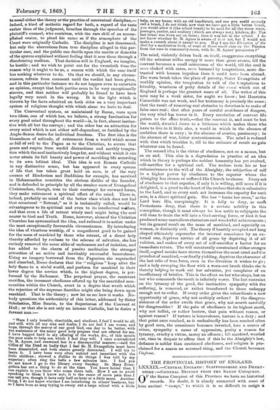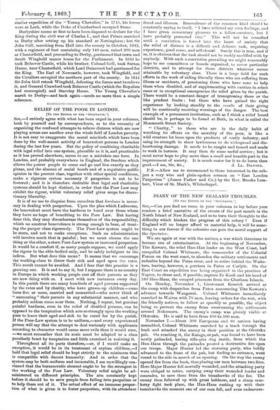THE PROVINCIAL HISTORY OF ENGLAND. LXXXIX.—CENTRAL ENGLAND : STAFFORDSHIRE AND DERRYSHIR E :—GENERAL HISTORY FROM THE SAXON CONQUEST.
OF the Saxon Conquest of this Province we have no historical records. No doubt, it is closely connected with some of hose ancient " camps," to which it is so difficult to assign a distinct origin, but which must have played an important part in the contests between the Romanized Britons and the Teutonic invaders. All that we know is that the two counties became part of that confederacy of Angle tribes included under the general name of Mercians—the Middle Angles, as they were styled in Bede's time, with reference to the earlier settlers on the east, to whom they were akin in race, and with whom Angle had then ceased to possess a merely geographical signification. Of the original Marks of these Mercian settlers Mr. Kemble has traced, from the existing names of places, 19 in Staffordshire and 14 in Derbyshire —by no means a large number, compared with other counties. Among these we may mention the Bobbingas (Bobbington—Staffordshire) ; Brimiugas (Brimington—Derbyshire, to which county they are peculiar) ; Cersingas (Cersington—Derbyshire, also peculiar) ; Dintingas (Dinting—Derbyshire, peculiar) ; Ecgingas (Eckington—Derbyshire) ; Ediugas (Edingale— Staffordshire) ; Essingas (Essington—Staffordshire, peculiar) ; Ettingas (Ettinghall —Staffordshire, peculiar) ; Heortingas (liartington—Derbyshire) ; Holingas (Hollington—Derbyshire and Staffordshire) ; Lullingas (Lullington —Derbyshire) ; Myrcingas (Marchington — Staffordshire) ; Paeccingas (Packington—Derbyshire and Staffordshire) ; Ridin' gas (Riddinge—Derbyshire) ; Stealliogas ((tallington—Staffordshire) ; Taedingas (Taddington —Derbyshire) ; Tibbingas (Tibbington—Staffordshire) ; Tissingas (Tissington—Derbyshire) ; Waesingas (Washington and Wessington—Derbyshire) ; Werringas or Hwerringas (Wherrington—Staffordshire, peculiar) ; Wittingas or Hwittingas (Whittington—Derbyshire and Staffordshire) ; Willingas (Willington —Derbyshire) ; Winningas (WinningtonStaffordshire) ; and Wittingas ( Withington—Staffordshire).
The Mercian principalities, we have already mentioned more than once, were late and reluctant converts to Christianity. The traditions of Staffordshire make Ceadde or Chad, afterwards canonized, to have been one of the first missionaries among the Pagan Mercians of that county, and to have had a cell at Stone. The county relapsed into Paganism after a brief period of Christian rule, but on the conversion of Wulfhere it is said that a bishopric was about A.D. 669 established at Licidfelde (Bede), the Lecefelle of Domesday Book, and the Lichfield of modern times. This name has been variously interpreted, but most probably is derived from a Saxon word meaning morass,—" the enclosed morass,"—such having been its actual state in early times. The establishment of a bishopric on such a site in the first success of Christianity among the Mercians is not improbable, as it is close to the site of the ruined Roman station of ETOCETUM, which, as the meeting-place of several great roadways, would be one of the most important positions in the Midland Counties. It is also close to the forest of Carnock, where the Mercian kings might indulge in the sports of the chase, and near which they would naturally fix one of their residences. Another seat of these kings is believed to have been at Tomaworthig (Tamworth) ; and Staefford (Stafford) was a vile of the same kings. There are the traces of an ancient camp or fort called the Burgh or Braff, near Maer.
Derbyshire also contained another,—perhaps the principal,— seat of the Mercian kings, viz., Rependun, or Repton, on the south bank of the Trent. Some antiquaries attribute to this date the crypt in Repton Church. Badecanwyl, now Bakewell, was also a Mercian town, though there are no Saxon ruins in it ; and the Saxon town which probably preceded the Danish Derby, in the neighbourhood of the Roman station at Little Chester, may be referred to the same period.
The Northman invasion of course overwhelmed Staffordshire and Derbyshire, and when the West Saxons turned the tide of conquest against the Northmen under the leadership of Alfred, the boundary of Watling Street, which marked out the portion of England assigned by treaty to the " Danes," gave the whole of Derbyshire and nearly the whole of Staffordshire to the Scandinavians. Derby then became one of their strongholds, now marked out as once theirs by the termination by, instead of the Saxon tun. There are "some works at Eckington, in the same county, which are known as the Danes' Balk, a doubtful camp at Hathersage, and the cemetery at Knowl Hill, near Foremark," according to tradition. The two counties had to be reconquered from the Scandinavians by Edward the Elder and his celebrated sister, Ethelfleda, the wife and widow of the Ealdorman of Saxon Mercia. In 910 a great battle was fought at Tootanheal (Tettanhall), in Staffordshire, in which the Danes were defeated ; and in 911 Edward's army overtook the Scandinavians as they were returning laden with spoil from an incursion into the Saxon territory, at Wodnesfeld, less than two miles west of Tettenhall, and in the battle which ensued it is said that the Danish kings Eowils and Haelfdene (and according to one account, also their brother, Ingvar), the jarls Ohter and Scurfa, with nine men of note, besides a considerable number of common people, were slain. Such, at any rate, is the account of the Saxon chroniclers, which (as Dr. Lappenberg dbserves) may perhaps be to some extent a repetition of accounts of earlier battles, the kings' names being a little suspicious in that respect.
There is a tradition at Lichfield of a famous battle there, in which three kings slew each other on the field. Two years after the second victory over the Scandinavians, Edward or Ethelfleda built fortresses at Tamworth and Stafford, and the next year one at Eadesbyrig, which some identify with Wednesbury. Ethelfleda died at Tamworth in 920, and Edward there assumed the direct reins of government of Mercia, securing his dominion by fortifying Bakewell and other places.
In the distribution of the great Saxon Earldoms in the reign of Edward the Confessor, it seems probable that in 1045 this Province was divided between Beorn and Leofric—Derby lying within the earldom of the former, and Stafford within that of thelatter—and that at the close of the year 1065, on the eve of the Norman Conquest, the whole was consolidated under the sway of Earl Edwin. During the Norman Conquest these counties of course to a great extent shared the fortunes of their Earl, Edwin, whose weak and vacillating conduct contributed so much to fix the Norman yoke more strongly on the Anglo-Saxon population. Domesday Book supplies us with the usual record of spoliation in this part of England. The Norman tenants-in-chief were then in Staffordshire 32, in Derbyshire 25 ; the under-tenants in the former county being 138, in the latter 75. In Staffordshire there were 912 bordarii, and in Derbyshire 719. In Staffordshire the
villani amounted to 1,728, the slaves to 212. In Derbyshire the villani were 1,840, the slaves only 20. We have also in the latter
county 128 persons enumerated under the head of sochemanni, so• that on the whole Derbyshire seems to have been the freer county of the two. The whole population enumerated in Domesday Book. under Staffordshire is 3,178 ; under Derbyshire, 3,041.
In the reign of Henry I. Staffordshire was ravaged by Robert de Belesme, in support of the claim of Robert of Normandy. In
the reign of Edward II. the Earls of Lancaster and Hereford were defeated by the King at Burton-upon-Trent. In the Wars of the Roses the Yorkist commander, the Earl of Salisbury, marching from the north towards London, in 1459, with 5,000 men, was intercepted at Blore-heath, on the western side of the county (between Drayton in Shropshire and Eccleshall) by log.* Lancastrians under Lord Audley. " The good generalship of Salisbury secured the victory. Lord Audley was killed, with all his chief officers, and (say the accounts) a fourth part of his army. A stone pedestal, surmounted by an ancient wooden cross marks the field of battle. Richard III. was with his army at Tamworth just before the battle of Bosworth Field."
After the Norman Conquest William Peverell, natural son of the Conqueror, built the Castle of the Peak in Derbyshire. In
the civil wars of the time of John, William Ferrers, Earl of Derby (whose family had great possessions in that county), and who was of the King's party, took the castles of the Peak and Bolsover. In the reign of Henry Ill., Ferrers, Earl of Derby, was one of the moat active of the Confederate Barons ; but be was defeated and taken prisoner by Henry, the King's nephew, in a battle at Chesterfield, and deprived of his earldom and the great possessions belonging to it, and they afterwards became attached to theDuchy of Lancaster, and thence passed to the Crown.
Staffordshire contained two of the principal prison-houses of Mary, Queen of Scots—Tutbury Castle and Chartley. At Holbeach House, between Wolverhampton and Stourbridge, most of the Powder Plot conspirators were taken or killed. During the civil war of Charles I.'s reign Staffordshire espoused, on the whole, the side of the Parliament, though some great families took the other side. Lichfield, with its cathedral and close, were occupied and garrisoned by the Earl of Chesterfield for the Royalists ; but taken by Lord Brooke's forces, with the loss, however, of that eminent leader, in March, 1643. The city was retaken about a month afterwards by Prince Rupert, who also took Burton. The Parliamentary forces under Sir William Brereton and Sir John Gell had about this time a severe but indecisive battle with the Royalists at Hopton Heath, near Stafford. The Parliamentarians occupied Stafford and Wolverhampton, took Eccleshall Castle, and took and demolished Stafford Castle ; they besieged Tutbury Castle without success. Leek was one of their posts, their horse having the advantage there in a skirmish ; and they were successful in two skirmishes with the Cavalier Colonel Hastings, in the latter part of 1643. In 1645 the King was in Staffordshire both before and after the battle of Naseby. After Worcester battle, the " King of Scots" took refuge at Boscobel House. In the very similar expedition of the "Young Chevalier," in 1745, his forces were at Leek, while the Duke of Cumberland occupied Stone.
Derbyshire seems at first to have been disposed to declare for the King during the civil war of Charles I., and that Prince marched to Derby after setting up his standard at Nottingham ; but Sir John Gell, marching from Hull into the county in October, 1642, with a regiment of foot containing only 140 men, raised 200 men at Chesterfield, and proceeding to Derby, garrisoned that town and South Wingheld manor house for the Parliament. In 1643 he took Bolsover Castle, while his brother, Colonel Gell, took Sutton House, near Chesterfield, which Lord Deincourt had garrisoned for the King. The Earl of Newcastle, however, took Wingfield, and the Cavaliers occupied the northern part of the county. In 1644 Sir John Gell retook Wingfield, defeating the forces sent to relieve it, and General Crawford took Bolsover Castle (which the Royalists bad reoccupied) and Staveley House. The Young Chevalier's march to Derby—and back again—needs no more than a simple reference.




































 Previous page
Previous page